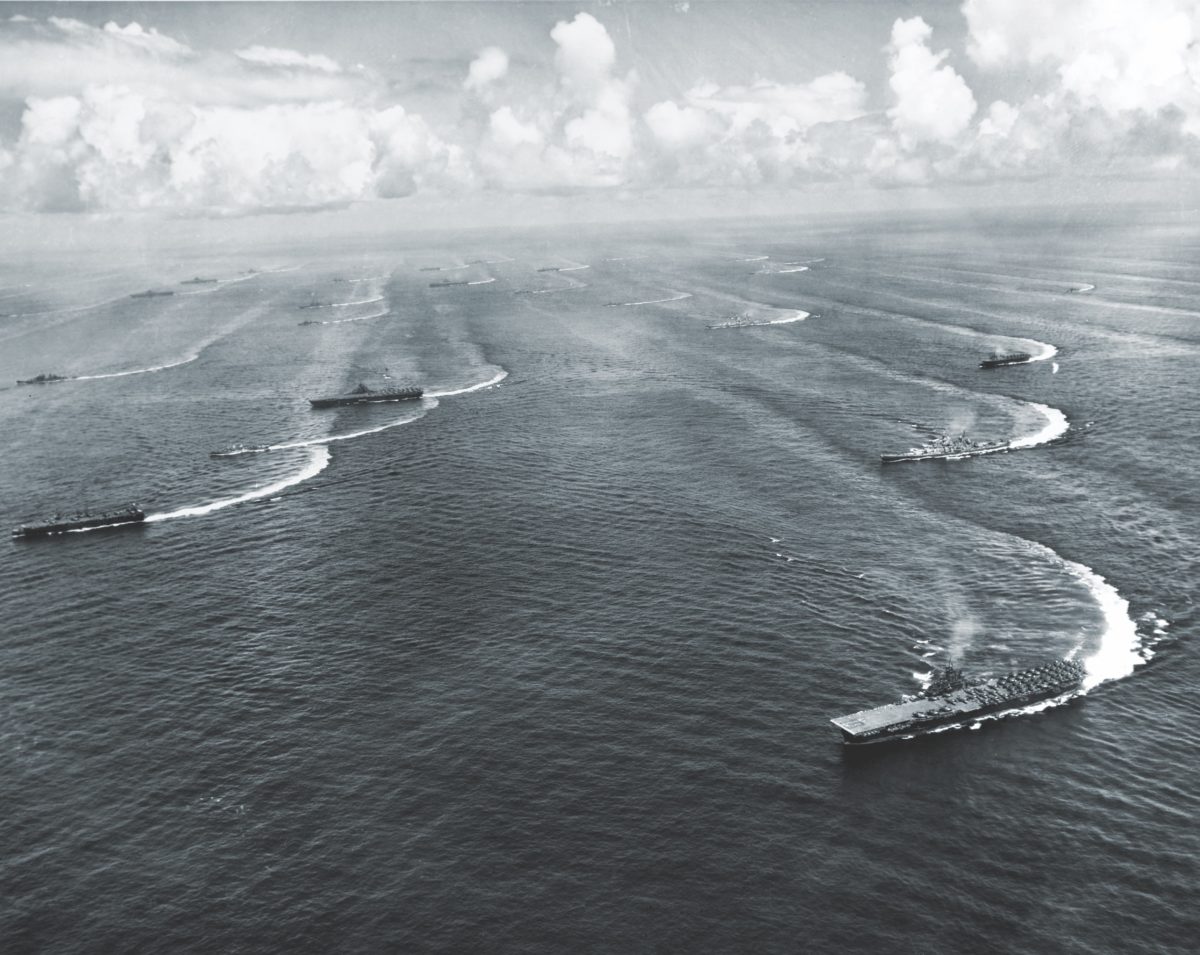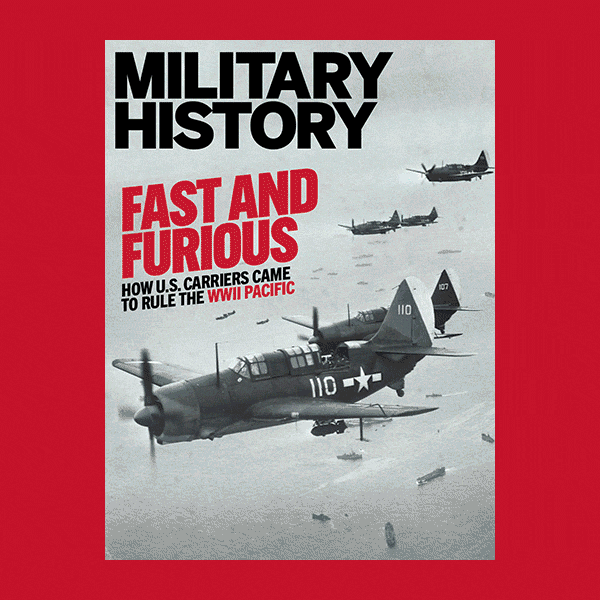The United States was inexorably drawn into the Pacific War, and indeed World War II, by Japan’s Dec. 7, 1941, surprise attack on Pearl Harbor, Hawaii. Well-trained Japanese naval aviators from the carriers Akagi, Kaga, Soryu, Hiryu, Shokaku and Zuikaku attacked in two waves, sending four battleships to the bottom, sinking or damaging many other ships, destroying or damaging more than 300 aircraft and killing some 2,400 American servicemen. The attack demonstrated the combat range of modern aircraft carriers and the vulnerability of traditional surface warships. Within days Britain’s vaunted Royal Navy lost its newest battleship, Prince of Wales, and its consort battlecruiser, Repulse, to Japanese air attacks off the coast of Malaya.
The lessons of such actions were not lost on Rear Adm. Chester Nimitz, whom President Franklin D. Roosevelt quickly promoted to admiral and appointed to command the U.S. Pacific Fleet. Nimitz reorganized the fleet into four task forces centered on the carriers Lexington, Enterprise, Hornet and Yorktown. The admiral then planned counteroffensive carrier raids against the Japanese, the most dramatic of which was the April 18, 1942, bomber strike on the Japanese home islands by 16 B-25s launched one-way at extreme long range from Hornet.
Hornet’s commander, Capt. Marc. A. “Pete” Mitscher, was a pioneering Navy flier and aggressive fighter who went on to command Task Force 38/58, arguably the most powerful armada in military history.
Despite such proof of aircraft carriers’ effectiveness, senior American naval officers remained generally convinced the battleship was the dominant weapon at sea. Its adherents were known as the “gun club.” The sea power doctrine of naval strategist Alfred Thayer Mahan dominated 20th century military thinking at the U.S. Naval Academy in Annapolis, Md., and the Naval War College, in Newport, R.I. The conflict between the “battleship admirals” and the generally younger generation of “aviation admirals” continued for the duration of the war.
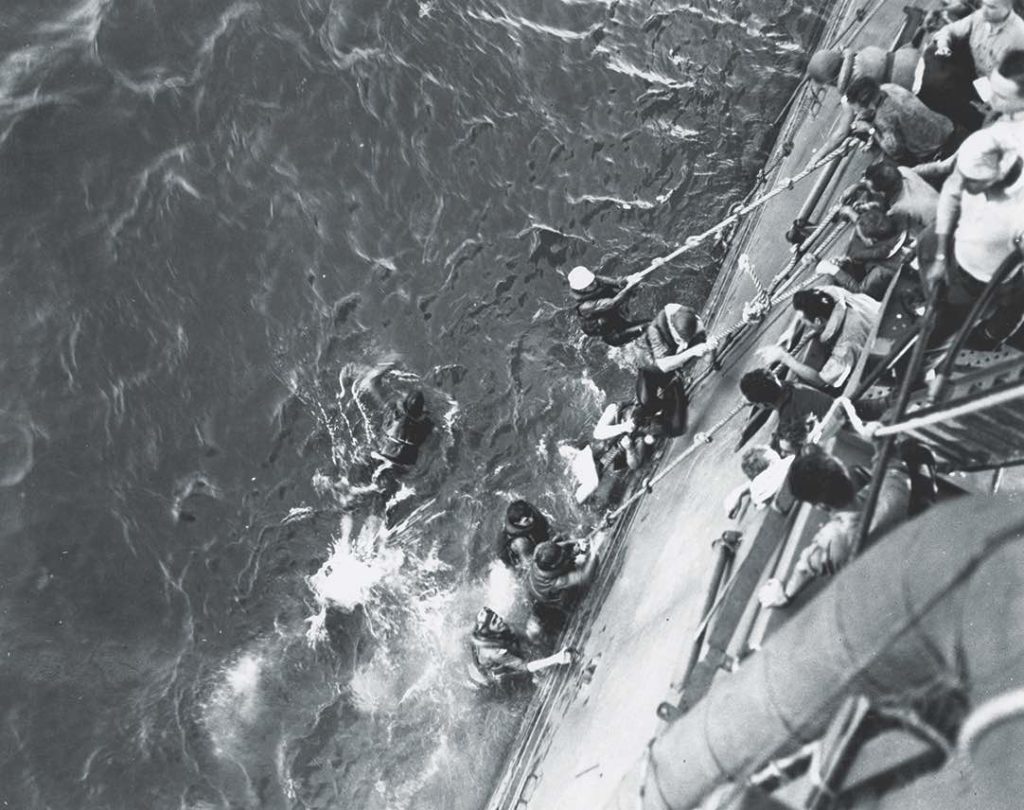
Facing the Imperial Japanese Navy (IJN) in the Pacific, the U.S. Navy initially played a weak hand. Fielding just four serviceable carriers with inferior aircraft, with the battleships damaged in Hawaii months from being serviceable, the Navy had few opportunities to mount an effective offense while waiting for American industry to produce ships, aircraft and weaponry. Still, the Navy had important assets. One was its cryptology department at Pearl Harbor, known as “Station Hypo,” which despite being understaffed and underfunded had been deciphering the IJN’s main communications code, JN-25, since 1940. Driven hard by Hypo’s director, Lt. Cmdr. Joseph J. Rochefort, the code breakers were able to unravel enough Japanese transmissions to furnish key intelligence to Navy brass by early 1942.
The import of their work was proved in the Battle of the Coral Sea, southeast of New Guinea. In April Adm. Ernest J. King, commander in chief of the U.S. Fleet and chief of Naval Operations, requested an assessment of Japanese strategic intentions. Rochefort responded that an enemy attack on Port Moresby, in Papua, New Guinea, was likely imminent. Nimitz responded by sending Yorktown and Lexington to the Coral Sea. The ensuing fight, in early May, was history’s first carrier-on-carrier engagement and was riddled with mishaps. Each side lost a carrier—Lexington and Shoho—leaving the outcome something of a draw.
Giving up their attempt to take Port Moresby, the Japanese focused on tiny Midway, the westernmost of the inhabited Hawaiian Islands. Admiral Isoroku Yamamoto, commander of the IJN’s Combined Fleet, was determined to destroy the remnants of the U.S. Pacific Fleet that had escaped destruction at Pearl, especially the aircraft carriers. Hoping to lure those carriers into a fatal trap, he devised a surprise attack on the American base at Midway with a strike force centered on four of the carriers—Akagi, Kaga, Hiryu and Soryu—that had attacked Pearl Harbor.
An avid poker player, Yamamoto went into action believing he held all the aces, but things did not go his way. Rochefort’s cryptanalysts learned the target and approximate date of the attack, the complete Japanese order of battle and the likely location of the attacking fleet. On June 3 the pilot of a Consolidated PBY Catalina scout plane spotted the approaching enemy invasion fleet.
The news galvanized Nimitz, who dispatched his three carriers—Enterprise, Hornet and Yorktown—to an assembly point northeast of Midway. With Vice Adm. William “Bull” Halsey hospitalized at Pearl with an infection, Nimitz put Rear Adm. Raymond Spruance in charge of Enterprise and Hornet, with Rear Adm. Frank Fletcher over Yorktown and in overall command.
The approaching Japanese fleet under Vice Adm. Chuichi Nagumo was unaware of the proximity of the American carriers and launched more than 100 aircraft to attack Midway early on June 4. Simultaneously the Midway forces dispatched all available combat planes to attack the Japanese. In the ensuing aerial melee most of those attackers were shot down. While Nagumo’s fliers did moderate damage to island installations, they lost 11 aircraft and sustained heavy damage to scores of others from the intense antiaircraft fire. To wreak a more destructive raid, Nagumo ordered his carrier commanders to rearm and change armaments on the Japanese planes—a time-consuming task.
Meanwhile, Fletcher had Enterprise and Hornet steam in the direction of the Japanese fleet to reduce distance to the targets. In consultation with Halsey’s chief of staff, Capt. Miles Browning, Spruance ordered an all-out launch while still at long range from Nagumo’s carriers, and Fletcher soon followed suit from Yorktown. Browning figured there was a good chance of catching the Japanese rearming and refueling, and he was right. Three squadrons of obsolete Douglas TBD Devastator torpedo bombers were shot down or turned back without scoring a single hit before the task force’s Douglas SBD Dauntless dive bombers saved the day. Striking when the Japanese decks were jammed with aircraft, bombs, torpedoes and fuel lines, the SBDs hit and mortally damaged Akagi, Soryu and Kaga.
Hours later another two dozen dive bombers converged on and pummeled Hiryu, which eventually sank. In one afternoon the U.S. Navy’s three-carrier strike force had changed the course of the Pacific War. Japan lost four of its fleet carriers, a heavy cruiser, some 250 attack aircraft and many of its best aircrews at the cost of Yorktown. Yamamoto ordered a retreat that night. The withdrawal marked the effective end of his drive to deliver a knockout blow to the U.S. Navy, leaving the IJN to face a naval war of attrition against the aroused industrial might of the United States.
The American victory at Midway had other consequences. The first was an urgent drive to upgrade all carrier aircraft, including the introduction of fighters able to best Japan’s A6M Zero. Grumman responded within months by rolling out the first production model F6F Hellcat. It could outrun, outclimb and outshoot the Zero, reach a higher operational ceiling, and it better protected pilots with armor and a self-sealing gas tank. The first combat-ready F6Fs reached the Pacific Fleet in February 1943. It proved the best carrier-based fighter of the war. Grumman also produced an exemplary carrier-based torpedo bomber, the TBF-1 Avenger.
While the dependable Dauntless remained the mainstay dive-bomber, Curtiss-Wright launched a more powerful carrier-based bomber, the SB2C Helldiver, though it was plagued with early problems and did not reach operational status until late 1943.
At the outset of the war Congress had appropriated funds to build additional aircraft carriers, resulting in the construction and launching of 13 Essex-class flattops, the 27,100-ton workhorses of the soon to be overpowering Pacific task forces. These were to be accompanied by dozens of escort (or “Jeep”) carriers carrying smaller complements of aircraft.
After Midway combat in the Pacific devolved into a series of skirmishes as each side built up its surface fleets and aerial forces. In early August 1942 a surprise amphibious landing by the 1st Marine Division at Guadalcanal, Tulagi and neighboring islands in the Solomons sparked weeks of hard fighting on land and sea with heavy losses. The sea battle—which involved the carriers Wasp (struck by three Japanese torpedoes, abandoned and scuttled), Saratoga and Enterprise (both heavily damaged and sent to Pearl for repairs)—was costly on both sides. For a time the newly arrived Hornet was the lone operational U.S. fleet carrier in the Pacific, before it too was sunk, leaving the soon repaired Enterprise as the sole operational American fleet carrier. The Japanese nearly recaptured Guadalcanal, but it ultimately remained in U.S. hands.
In 1943 the balance of naval power shifted to the Americans as the Essex-class carriers and their improved aircraft arrived in the Central Pacific under Nimitz’s command. Major U.S. shipyards worked around the clock, launching some Essex-class flattops in only 16 months. Six were commissioned in 1943 and seven more in 1944. The new carriers featured improved radar and communications. Each bore 36 fighters, 36 dive bombers and 18 torpedo bombers. The carriers also bristled with antiaircraft guns: a dozen turret-mounted 5-inch guns with a range of 10 miles, as many as 18 quad-mounted 40 mm Bofors guns and upward of fifty-five 20 mm Oerlikon cannons. In this industrial/weapons race, it was already clear in 1943 that Japan could not keep pace with U.S. shipbuilding. Moreover, given the nature of its extensive pilot training, Japan would be unable to replace its hemorrhaging losses of thousands of first-rate pilots.
In 1943 a new American doctrine of carrier-based warfare split naval assets in the Pacific into two large fleets: the Third (in the South Pacific under Halsey) and the Seventh (in the Southwest Pacific under General Douglas MacArthur). In 1944 the Third formed the basis of the Fifth Fleet (in the Central Pacific under Spruance), the fleet designation and command toggling back and forth between Spruance and Halsey. Most new fleet carriers and Independence-class light carriers were assigned to the Central Pacific. That summer Essex and the new Yorktown and Lexington arrived at Pearl Harbor along with the light carriers Independence, Princeton and Belleau Wood. Here began the multicarrier task groups that, as naval historian Clark G. Reynolds explained in his definitive 1968 book The Fast Carriers, formed the “principal offensive element” that would attack the Japanese-held Gilbert and Marshall islands.
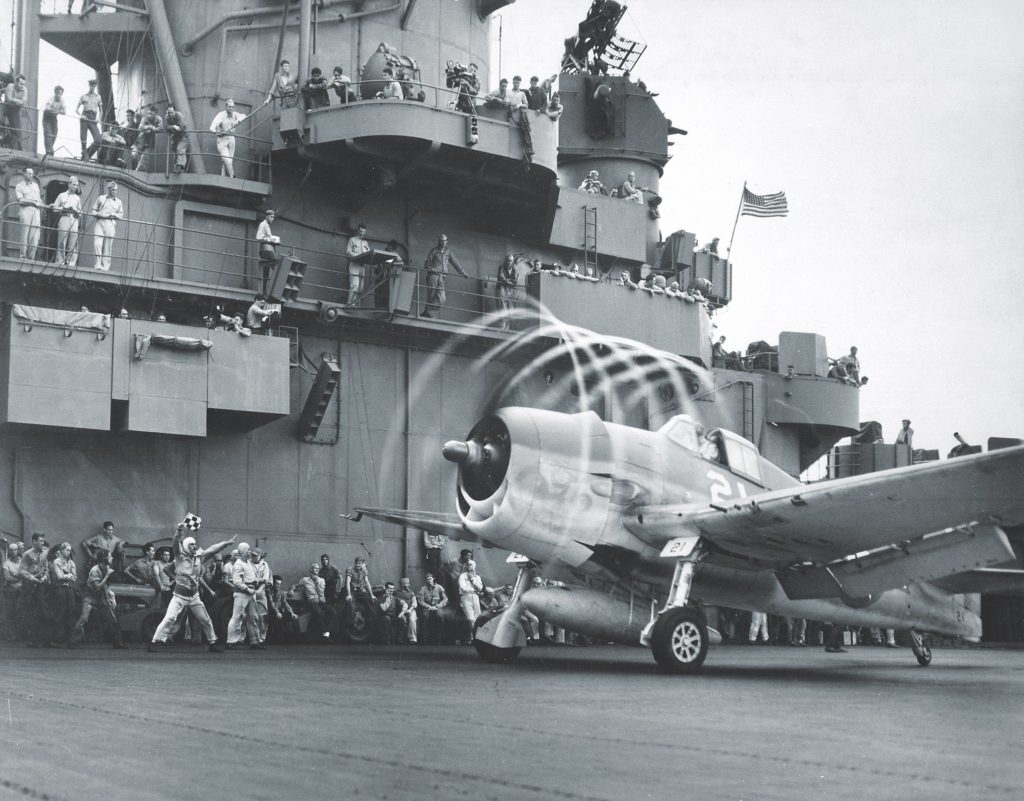
Recognizing the vulnerability of a task force built around one or two carriers, the new doctrine posited deploying three to six fleet carriers at the center of a circular formation, ringed by cruisers and destroyers bristling with antiaircraft guns, and escort carriers, each carrying 30 attack aircraft, accompanied by the newest fast battleships with speed to match the carriers. The main offensive weapon of these task forces was their 500-1,100 attack aircraft, able to range out to 1,500 miles.
The innovative offensive doctrine under which the new fast carrier task groups would operate was essentially created by then Vice Adm. Marc Mitscher. In late January 1944 Mitscher prepared to launch Operation Flintlock, the battle to take the Japanese stronghold of Kwajalein in the Marshalls. By then his fleet was operating as Task Force 58 (TF 58) and comprised a dozen carriers in four task groups of three carriers each, with a combined complement of 650 attack aircraft.
The Battle of Kwajalein began on January 31 with aerial assaults and the bombardment of its defenses by battleships and destroyers. By noon the carrier fighters had cleared the skies of Japanese aircraft. Marine and Army forces landed on February 1. After three days of fighting and relentless air attacks the island was in American hands. So too was the vast anchorage at adjacent Majuro Atoll, which became the new forward base for the Central Pacific fleet.
From Majuro TF 58 moved in mid-February to attack Truk, the heavily fortified “Gibraltar of the Pacific” and capital of the Carolines.
As Reynolds wrote in The Fast Carriers:
“A predawn-launched 72-plane fighter sweep on 17 February opened the air attack against “impregnable” Truk.…About 80 Japanese planes and heavy, inaccurate flak challenged Mitscher’s sweep, but only half the Zeros sought to engage. For most of the morning the air battle raged, resulting in the loss of 50 Zeros and four Hellcats.…The carrier planes then strafed the parked aircraft on three strips and destroyed or damaged about 150 in all, leaving another 100 undamaged.…The bombers went directly to work and had a field day. Before Task Force 58 left Truk, about 140,000 tons of enemy shipping lay sunken or piled up on the beach.…One aviator who observed this handiwork pointed out: “This is how we can win battles in the future. Teamwork is the answer.”
Indeed, the Truk attacks served as prototypes for TF 58’s 1944 and ’45 victories over Japanese air forces and their many island bases. Key American advantages enabled those wins. Surprise was often a factor, thanks to the task force’s unprecedented mobility—and thanks to the fact the Japanese never realized their naval code had been broken. Japanese pilots diminished in proficiency, as many of their initial elite flyers were lost by 1944, and their substitutes were no match for veteran American pilots.
As a growing number of U.S. carriers and battleships arrived in the Pacific, the Navy’s success in neutralizing Japanese strongholds in the Marshalls and Carolinas opened the way to all-out attacks on the Marianas—Tinian, Saipan, Guam and Rota. That island group’s strategic importance loomed large: American air bases on those islands would enable the Boeing B-29 Superfortress bomber—with its 3,250-mile range and ability to carry up to 10 tons of bombs—to rain destruction on the Japanese home islands.
Code-named Operation Forager, the 1944 assault on the Marianas proved decisive, and its chief weapon was TF 58. It was at that point King split the fleet into two commands—one to strike, the other to plan. The same powerful fast carrier task force known as TF 58 in the Fifth Fleet under Spruance and Mitscher was called TF 38 in the Third Fleet under Halsey and Vice Adm. John McCain. The flip-flopping designation understandably confused the Japanese. In June TF 58 steamed toward the Marianas with 15 flattops carrying more than 900 aircraft, seven battleships, 20-odd cruisers and dozens of destroyers. The Americans would employ that mighty armada just in the preparation of the Marianas landings. The total didn’t include the scores of ships that would transport nearly 130,000 Marine and Army troops to the beaches.
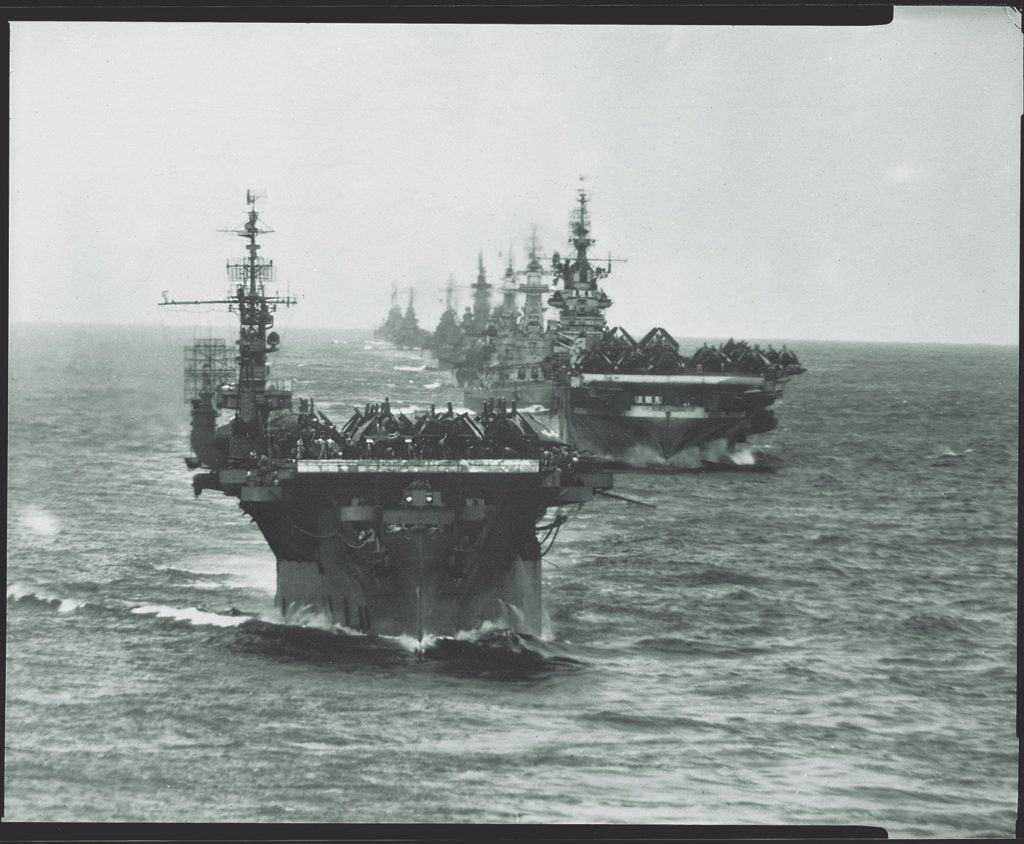
Mitscher kicked off Forager on June 11 by sending some 200 F6F Hellcats to ravage Japanese air bases on Saipan. That strike kicked off a week of carrier-based raids, followed by a two-day bombardment. The initial landing took place on June 15, some 20,000 Marines making it ashore that day.
Desperate to hang on to the Marianas, Japanese Vice Adm. Jisaburo Ozawa mustered his entire 1st Mobile Fleet—five battleships and nine carriers, including the newly launched Taiho, Ozawa’s flagship—to counterattack in what is remembered as the Battle of the Philippine Sea, the largest carrier-on-carrier engagement of the war. Mitscher and Ozawa each perceived it as an opportunity to destroy his enemy’s main Pacific fleet.
As the Japanese fleet approached Saipan from the west, U.S. submarines tracked and reported its progress. Ozawa opened the fight around 10 a.m. on June 19, launching the first of four waves of 373 carrier-based aircraft. American radar operators spotted them 100 miles out, and Mitscher sent every Hellcat he had—nearly 300—screaming into the air.
The Japanese pilots were outmatched, and the greatest naval air battle of the war was a slaughter, dubbed by one jubilant American flier as “an old-time turkey shoot.”
It was over by 3 p.m. Ozawa lost two-thirds of his aircraft. Mitscher lost 20 Hellcats.
That same day U.S. submarines made the victory even more lopsided by torpedoing and sinking two Japanese fleet carriers, Shokaku and Taiho. It was a portent of things to come in the Pacific. American submarines armed with improved torpedoes played a growing role in destroying not only IJN assets but also merchant ships carrying oil and other strategic materials.
The summer of 1944 was characterized by a series of raids and invasions of minor islands in the Marianas and elsewhere. The next major battle, for the Leyte Gulf in late October, marked the opening of the MacArthur-driven campaign to liberate the Philippines. Leyte proved history’s last battleship-on-battleship fight, as well as the largest naval battle in modern history in numbers of warships engaged—more than 280, including the ships of Halsey’s Third Fleet. It also marked the end of the IJN as an offensive fighting force.
Ominously, the Battle of Leyte Gulf also saw the first organized attacks by Japanese kamikaze (“divine wind”) aircraft. As most of their veteran aircrews had perished, the IJN instead trained its young green pilots to crash into Allied warships. In the fight for the Philippines the kamikazes represented a serious threat, sinking the escort carrier St. Lo and damaging the fleet carriers Essex, Franklin, Hancock, Intrepid and Lexington, the light carriers Belleau Wood and Cabot, and more than a half dozen escort carriers, all of which retired for repairs. The only real defense against such attacks was accurate and relentless antiaircraft fire—but against dozens, even hundreds, of kamikazes it would never be 100 percent effective.
With the Marianas in American hands by year’s end, and the battle to liberate the Philippines well underway, the next islands to be contested were Iwo Jima, in the Bonin Islands, and Okinawa, in the Ryukyus. The Americans invaded the former in February 1945, the latter in April. Iwo Jima lay some 760 miles south of Tokyo, close enough to enable land-based fighter planes to escort squadrons of B-29s.
Both Iwo Jima and Okinawa are volcanic in origin, with rugged mountainous topography, and were desperately defended by fanatical Japanese troops for whom there would be no going home. Task Force 58, then at its peak in strength and experience, committed to prolonged aerial assaults on both islands and took the brunt of swarming kamikaze attacks. Those attacks proved more deadly and damaging than encounters with the carriers and battleships of the IJN, which by then was essentially toothless.
En route to Iwo Jima on February 16 and 17 Spruance was granted his long-standing wish to strike the Japanese home islands and launched more than 1,000 aircraft from TF 58 to attack enemy air bases, factories and other installations and engage any remaining combat aircraft. The attacks were a success, inflicting widespread damage, sinking several ships and downing some 500 Japanese planes at a cost of 88 U.S. fighters, 60 of those in combat.
At Iwo Jima TF 58 provided pre-landing bombardment support and aerial attacks through late February while continuing raids against the home islands. On February 21 kamikazes severely damaged Saratoga and sank the escort carrier Bismarck Sea. The invasion cost the lives of nearly 7,000 Marines and more than 500 sailors with another 20,000 wounded. On the Japanese side the 21,000-man garrison was all but wiped out.
Once in American hands Iwo Jima served as a valuable emergency haven for damaged B-29s and a base for fighter escorts assigned to bomber strikes on the home islands.
Coming on the heels of Iwo Jima, the April 1 invasion of Okinawa proved the bloodiest single battle of the Pacific. As at Iwo Jima, Task Force 58 provided pre-landing bombardment support and aerial attacks against Okinawa while fending off repeated kamikaze attacks by more than 300 planes in just the first week of battle. A protracted series of kamikaze attacks stretched through May, costing the Japanese at least 1,500 aircraft (and pilots) and the Americans a dozen lost destroyers and hundreds of damaged ships. Through war’s end kamikazes managed to cripple the fleet carriers Bunker Hill, Enterprise, Hancock, Intrepid and Wasp.
Among the desperate Japanese measures to hold Okinawa was a task force centered on the new outsize battleship Yamato, dispatched to disrupt the U.S. invasion. Mitscher launched nearly 400 carrier-based aircraft to intercept the formation. The massive Yamato finally capsized and sank after hits from at least 11 torpedoes and a half dozen bombs.
Altogether Allied naval forces lost more than 30 ships and more than 760 carrier-based aircraft in the Okinawa campaign. Nearly 5,000 U.S. sailors were killed, as were some 7,600 soldiers and Marines. Japan lost an estimated 110,000 soldiers and Okinawan conscripts by the time fighting there ended on June 21.
Task force raids on Japan then complemented the ongoing incendiary B-29 devastation wrought by U.S. Army Air Forces Maj. Gen. Curtis LeMay’s XXI Bomber Command. Throughout the summer of 1945, as Allied planners prepared for the invasion of Japan (Operation Downfall), air and sea attacks on the home islands mounted.
The final curtain was about to fall on the Pacific War, which it did abruptly with the dropping of the two atomic bombs. Only on August 15, when Emperor Hirohito declared Japan’s unconditional surrender, did Nimitz halt all combat operations of the storied fast carrier task groups. MH

